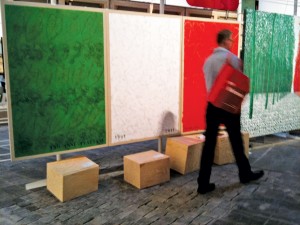« Features
PUSH TO FLUSH / The Rhetorics of Nationalism
 (On Venice Biennale’s ILLUMInations)
(On Venice Biennale’s ILLUMInations)
By Paco Barragán
For people in Venice that aren’t necessarily so well informed in art matters, “ILLUMInazioni - ILLUMInations” might make them think of a kind of light show…
Obviously the title is not very bright and shining. To be more precise: this contradictio in terminis in the title is a cheap, lamentable boutade. The curator’s text only makes things worse: “ILLUMInations presents contemporary art characterized by gestures that explore notions of the collective, yet also speak of fragmentary identity, of temporary alliances, and objects inscribed with transience.” Besides, Bice Curiger - according to the press release - has encouraged mutual exchanges between artists of her exhibition and those hosted in the national pavilions by asking “five questions on the themes of identity and their sense of belonging,” which I feel obliged to put under the reader’s eye: 1) is the artistic community a nation? 2) how many nations do you feel inside yourself? 3) where do you feel at home? 4) does the future speak English or another language? 5) if art was a nation what would be written in its constitution?
Sorry, but I don’t hear any symphony in my head. Actually, the whole thing is, for want of a better word, regressive… if it weren’t that she totally misses the point (to be honest: I’m dying to answer these questions!).
Now, let’s get to the heart of the matter: unlike what Curiger affirms, ‘nations’ don’t illuminate anything. On the contrary, they are the heart of darkness of contemporary times: not only now but throughout history ‘nation’, ‘nationality’ and ‘nationalism’ have become xenophobic by stressing negative elements of identity and creating artificial divisions between natives and non-natives. I would dare to say that ‘nationalism’ is to the 21st century what utopia was to the 20th century! Besides, it’s obvious that the nation-state is a concept that has become totally inappropriate in a globalized world. The pan-Arabic movements, the London riots and the actual economic crisis have shown clearly that national governments have no control over the lives of its citizens. But, let’s stop talking about politics: the show was badly argumented and badly installed (will anyone ever tell the Biennale that the Arsenale as an exhibition premise is horrible, and that the setting competes ferociously with most of the art works installed? Paint it white, for God’s sake, and spare future curators that nightmare!).
This brings us to the still ongoing contradictio in terminis: the national pavilions. In a globalized world, with its ease of travel, international employment, and artistic communities, along with funding/grant opportunies, and international museum exhibitions, is it still of importance where the artist comes from? Are we still defining art by its passport or by its geographical pedigree?
It’s really exciting to see once again how many national pavilions at Venice try to negotiate this old-fashioned imperative. Some countries hire foreign curators -Denmark, Chile, Georgia, Iceland, Iraq, Israel, Norway, Syrian Arab Republic, United Arab Emirates - while other countries invite foreign artist to their pavilions. Just remember in earlier editions with Liam Gillick at the German Pavilion, and Alicia Framis at the Dutch Pavilion. This year, Yael Bartana was invited to exhibit at the Polish Pavilion and Han Hoogerbrugge, Runo Lagomarsino, Sharon Hayes, Stelios Faitakis, and many more participated in the Danish Pavilion.
Now, do these national pavilions add anything in terms of artistic discourse? Not really. Is it necessary that the Venice Biennale looks like a 19th century ‘great exhibition’ where every country tries to compete with each other in terms of artistic excellence? Not at all. Did we see anything interesting at the national pavilions at the 54th Biennale? Germany (Christoph Schlingensief): outstanding; Egypt (Ahmed Basiony): very strong and sensible; Poland (Yael Bartana): problematic semitic enthusiasm, which next to Egypt sounded all the more strange; Great Britain (Mike Nelson) and The Netherlands (various artists): both correct; Finland (Vesa-Pekka Rannikko): good pictorial site-specific intervention; USA (Allora & Calzadilla): glorifyingly insignificant; France (Christian Boltanski): good, but too traditional; Spain (Dora Garcia): falsely intellectual; Belgium (Angel Vergara): great work and enthusiastic promotion by its curator, Luc Tuymans; Russia (various artists): is Boris Groys, as curator, not aware that he is legitimating the Russian un-democratic regime? Italy (various artists): a Berlusconian circus by reactionary curator Vittorio Sgarbi; Iceland (Libia Castro and Ólafur Ólafsson): provocative; Latin American Pavilion (various artists): too many artists, badly mounted, and the video by Martin Sastre bathes the whole exhibition in an unbearable banality… in sum, fake versus real politics!
We need to cut bait here: the best exhibition at the Venice Biennale was not at the Arsenale. It was not at a ‘traditional’ national pavilion, and it was not curated by a national curator. It was “Speech Matters” at the Danish Pavilion, curated by Greek Katerina Gregos, and comprised of mostly foreign non-Danish artists, who tackled an important and relevant topic: freedom of speech.
The last editions of the Venice Biennale have been artistically unreliable: Robert Storr turned the Biennale into a salon; Daniel Birnbaum’s edition “didn’t make much worlds;” and Bice Curiger turned it into a zero degree show. Who should we blame for this? Or is the Biennale just simply over the hill and incapable of making the world a better place? The world a better place… cool, right?



































